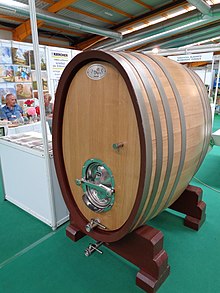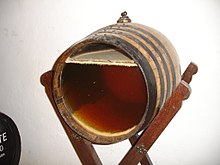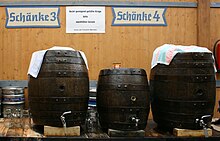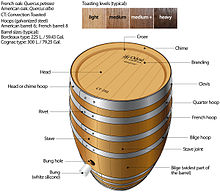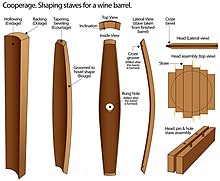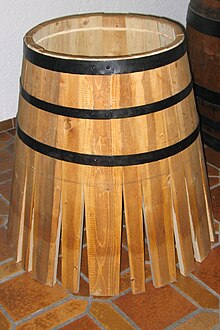
A hogshead is a large cask of liquid. More specifically, it refers to a specified volume, measured in either imperial or US customary measures, primarily applied to alcoholic beverages, such as wine, ale, or cider.

Whisky or whiskey is a type of liquor made from fermented grain mash. Various grains are used for different varieties, including barley, corn, rye, and wheat. Whisky is typically aged in wooden casks, which are typically made of charred white oak. Uncharred white oak casks previously used for the aging of port, rum or sherry are also sometimes used.

Single malt whisky is malt whisky from a single distillery.

Rye whiskey can refer to two different, but related, types of whiskey:

A barrel is one of several units of volume applied in various contexts; there are dry barrels, fluid barrels, oil barrels, and so forth. For historical reasons the volumes of some barrel units are roughly double the volumes of others; volumes in common use range approximately from 100 to 200 litres. In many connections the term drum is used almost interchangeably with barrel.

A drum is a cylindrical shipping container used for shipping bulk cargo. Drums can be made of steel, dense paperboard, or plastic, and are generally used for the transportation and storage of liquids and powders. Drums are often stackable, and have dimensions designed for efficient warehouse and logistics use. This type of packaging is frequently certified for transporting dangerous goods. Proper shipment requires the drum to comply with all applicable regulations.

A cooper is a person trained to make wooden casks, barrels, vats, buckets, tubs, troughs and other similar containers from timber staves that were usually heated or steamed to make them pliable.

Oak is used in winemaking to vary the color, flavor, tannin profile and texture of wine. It can be introduced in the form of a barrel during the fermentation or aging periods, or as free-floating chips or staves added to wine fermented in a vessel like stainless steel. Oak barrels can impart other qualities to wine through evaporation and low level exposure to oxygen.
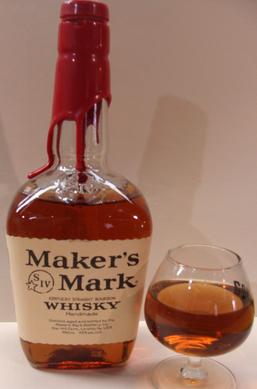
Maker's Mark is a small-batch bourbon whiskey produced in Loretto, Kentucky, by Beam Suntory. It is bottled at 90 U.S. proof and sold in squarish bottles sealed with red wax. The distillery offers tours, and is part of the American Whiskey Trail and the Kentucky Bourbon Trail.

A keg is a small cask.
Malt whisky is whisky made from a fermented mash consisting of malted barley. If the product is made exclusively at a single distillery, it is typically called a single malt whisky. Although malt whisky can be made using other malted grains besides barley, those types are not called malt whisky without specifying the grain, such as rye malt whisky or buckwheat malt whisky.

Established in 1857, J.P. Wiser's Whiskey is one of Canada's oldest whiskey producers. Since 1935, J.P. Wiser's Whiskey has held a majority stake in Corby Spirit and Wine. In 2005 the international Liquor company Pernod Ricard, took ownership of both companies. Hiram Walker & Sons Limited currently produce J.P. Wiser's whiskey at their Windsor, Ontario, distillery.

Cask strength is a term used by whisky and rum producers to describe a whisky or rum that has not been substantially diluted after its storage in a cask for maturation. The level of alcohol-by-volume (ABV) strength for a cask strength whisky or rum is typically in the range of 52–66% ABV.
Nelson's Green Brier Distillery is a whiskey distillery located in downtown Nashville, Tennessee that produces different varieties of Tennessee whiskey and bourbons. The distillery offers daily public tours and tastings as well as a large mercantile shop with bottles, barware and apparel available for purchase. In July 2023, Nelson's Green Brier Distillery opened a newly renovated distillery restaurant and full-service bar at their 1414 Clinton St. Nashville, TN 37203 location. The same facility also now offers four new private event and dining spaces available to rent for corporate functions, weddings and celebrations of varying sizes.
Capacities of wine casks were formerly measured and standardised according to a specific system of English units. The various units were historically defined in terms of the wine gallon so varied according to the definition of the gallon until the adoption of the Queen Anne wine gallon in 1707. In the United Kingdom and its colonies the units were redefined with the introduction of the imperial system whilst the Queen Anne wine gallon was adopted as the standard US liquid gallon.
Capacities of brewery casks were formerly measured and standardised according to a specific system of English units. The system was originally based on the ale gallon of 282 cubic inches. In United Kingdom and its colonies, with the adoption of the imperial system in 1824, the units were redefined in terms of the slightly smaller imperial gallon. The older units continued in use in the United States.
A number of units of measurement were used in South Africa to measure quantities like length, mass, capacity, etc. The Imperial system of measurements was made standard in 1922 and the metric system was adopted in 1961.

A barrel-aged beer is a beer that has been aged for a period of time in a wooden barrel. Typically, these barrels once housed bourbon, whisky, wine, or, to a lesser extent, brandy, sherry, or port. There is a particular tradition of barrel ageing beer in Belgium, notably of lambic beers. The first bourbon barrel-aged beers were produced in the United States in the early 1990s.
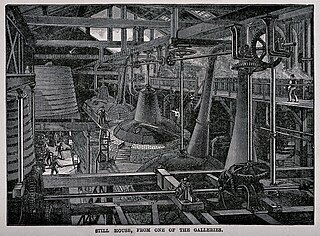
The following outline is provided as an overview of and topical guide to whisky:


